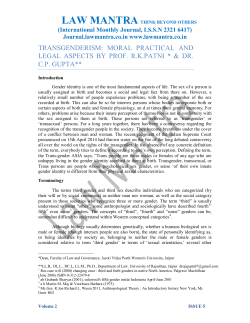
Beyond 4 Walls and a Roof - Center for American Progress
AGENCY/PHOTOGRAPHER Beyond 4 Walls and a Roof Addressing Homelessness Among Transgender Youth By Hannah Hussey February 2015 W W W.AMERICANPROGRESS.ORG Introduction and summary The number of unaccompanied homeless youth in the United States is alarming, with some experts comparing it to an epidemic. Studies indicate that lesbian, gay, bisexual, and transgender, or LGBT, youth comprise a disproportionate percentage of these young people—approximately 40 percent.1 In some regions, 25 percent to 37 percent of LGBT high school students are or have recently been homeless.2 Unfortunately, little research considers the unique experiences of transgender youth, a group that includes minors as well as young people in their late teens and 20s. The information that is available indicates that transgender individuals experience a range of health and wellness disparities compared with their cisgender peers. Family rejection; inadequate social services; and discrimination in housing, employment, and education make it difficult for transgender young people to secure a safe and affirming place to live. Once homeless, transgender youth too often find that shelters are unwelcoming or unavailable, health care is inaccessible, and law enforcement systems are unhelpful. As more youth transition at earlier ages, they become both more visible and more susceptible to family rejection and societal discrimination. Surveys suggest that increasing numbers of transgender youth are homeless—or at least that a larger share are outing themselves to service providers. For instance, one study of service providers working with LGBT homeless youth found that more than three-quarters reported having worked with transgender clients in the previous year—a significant increase over 10 years before, when fewer than half reported serving homeless transgender clients.3 Immediate attention to these young people is vital to improve their health and safety. 1 Center for American Progress | Beyond 4 Walls and a Roof This report compiles existing research in order to provide an overview of the demographics of transgender homeless youth, their experiences while homeless, and the factors that contribute to homelessness and housing instability among this community. It also outlines a series of recommendations for federal, state, and local policymakers to meet the housing needs of transgender young people and to improve outcomes for those experiencing homelessness. In particular, this report focuses on the following mechanisms for preventing and ending homelessness: • Providing the resources needed for homeless and at-risk transgender youth to stabilize their lives, including shelters and transitional living programs, skill-building opportunities, health promotion programs, and family intervention services • Implementing strong nondiscrimination policies and eliminating barriers to services in shelters, health care, vital records, and law enforcement • Addressing the root causes of homelessness through changes to the interlocking systems that hold transgender youth back from reaching their full potential, including housing, employment, education, public accommodations, juvenile justice, and foster care • Expanding data-collection efforts to include gender identity in respectful and confidential ways In the face of adversity, many homeless transgender youth are demonstrating tremendous resilience by building tight-knit peer support networks, leading community organizing and advocacy efforts, and simply surviving despite the odds against them. As they seek to pursue their passions, these young people need targeted support and policy interventions in order to achieve positive social, economic, and health outcomes as they navigate and contribute to the world around them. While the drivers of youth homelessness are complex and solutions will take time, no commitment to seeing all youth safely housed will be complete until policymakers, service providers, researchers, and advocates join transgender young people in celebrating who they are and who they could grow to be. 2 Center for American Progress | Beyond 4 Walls and a Roof Key terms4 The following terms are defined as used in this report. See the endnotes for further information and additional meanings. Cisgender: A term that describes a person whose gender identity matches their sex assigned at birth. Gender identity: An individual’s internal view of their own gender, an inner sense that could include being a man, a woman, both, neither, or something else entirely. Gender expression: The manner in which a person represents or expresses gender to others, often through behavior, clothing, hairstyles, activities, voice, and mannerisms. Gender nonconforming: A broad description that may include people whose gender expression or gender identity is neither masculine nor feminine or is different from traditional or stereotypical gender expectations. Some individuals prefer the terms gender variant or gender expansive. Gender-nonconforming youth may or may not identify as transgender or as lesbian, gay, or bisexual. Genderqueer: An umbrella term that includes people whose gender identities or expressions may be neither male nor female, between or beyond genders, or some combination of genders. 3 Center for American Progress | Beyond 4 Walls and a Roof The Center for American Progress is a nonpartisan research and educational institute dedicated to promoting a strong, just, and free America that ensures opportunity for all. We believe that Americans are bound together by a common commitment to these values and we aspire to ensure that our national policies reflect these values. We work to find progressive and pragmatic solutions to significant domestic and international problems and develop policy proposals that foster a government that is “of the people, by the people, and for the people.” 1333 H STREET, NW, 10TH FLOOR, WASHINGTON, DC 20005 • TEL: 202-682-1611 • FAX: 202-682-1867 • WWW.AMERICANPROGRESS.ORG
© Copyright 2025





















